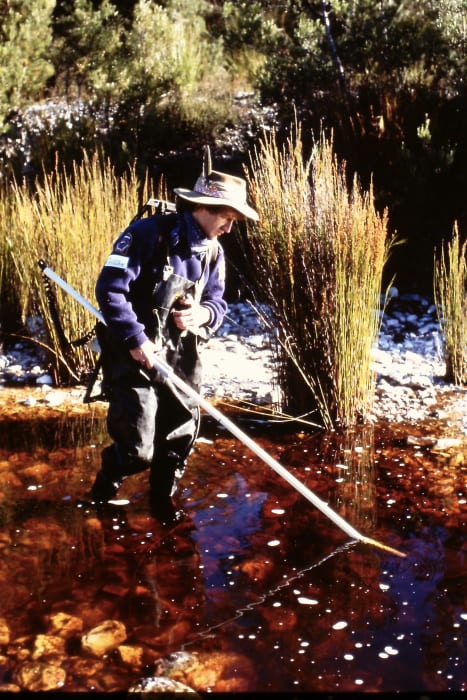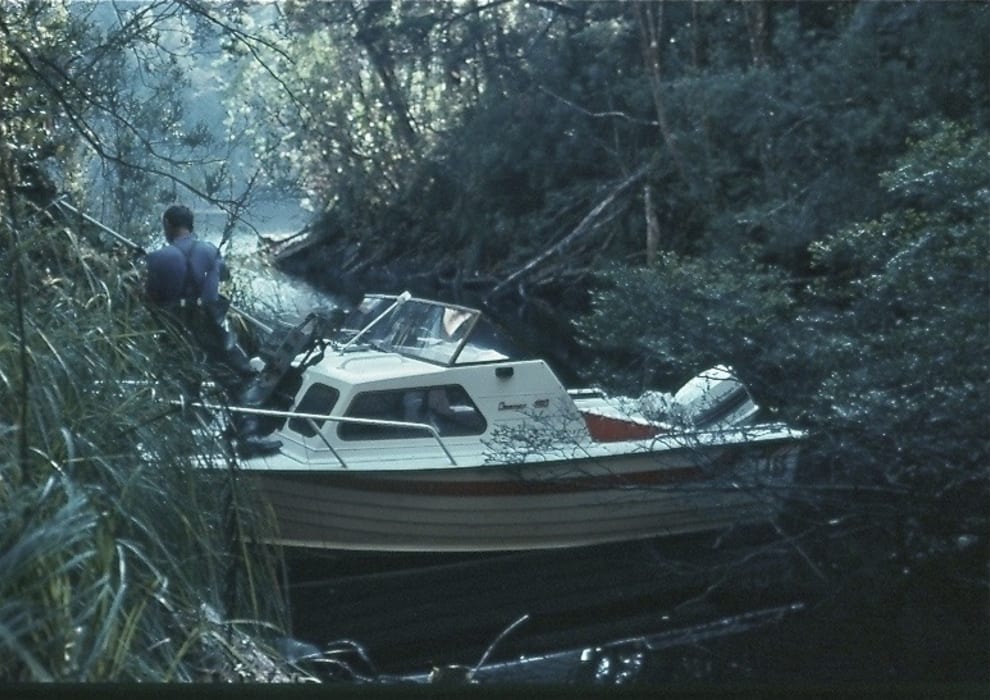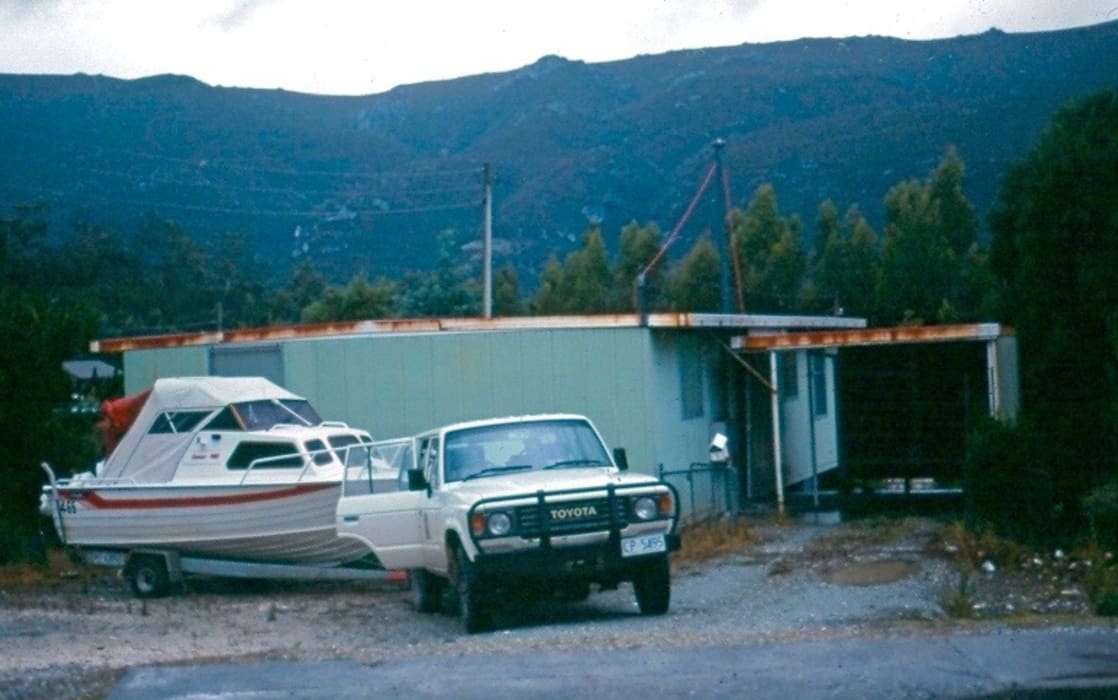We usually stayed in the south-west five days at a time. The surveys started promisingly – we found some Pedder galaxias in the two Bonnet Bay creeks (near the location of the original lake) … and we even got one fish in a new location, Stillwater Creek. We had high hopes, but sadly we never found another in that stream. The one we found was a large, old fish and perhaps the last survivor in that stream.
writer and photographer Dr PREMEK HAMR
PART 1: THE CRASH
Lake Pedder was unique, a jewel in the crown of what later was named the Tasmanian Wilderness World Heritage Area. Its pink quartzite beach and dark golden waters were famous among bushwalkers who made the one-week trek from the nearest access road. It was the smallest of a handful of large natural lakes in Tasmania, but arguably the most beautiful.
The Pedder catchment was inhabited by two endemic species of fish: the Pedder galaxias and the smaller swamp galaxias. They lived happily isolated in the lake and its adjoining streams, the smaller fish apparently preferring the more shallow, slow flowing streams and swampy areas. Little was known of their biology and ecology because of the remoteness of the lake. The Pedder galaxias is a pretty, small to medium fish (7 to 15cm as an adult), yellow brown with gold highlights and dark brown-black mottled pattern. It fed on aquatic and terrestrial invertebrates and, as the largest local resident, outside of perhaps the odd spiny freshwater crayfish, was the ruler of the lake.
Although the area was designated a national park in 1955, in 1967 Lake Pedder was to be “enlarged” as part of the hydro power development by the government of then premier Eric Reece. Despite the ensuing furore and now well-known battle by environmentalists and many members of the Tasmanian as well as the Australian public, the lake was inundated in 1972.
The loss was great, but it resulted later in the saving of the Franklin River and in the formation of the Tasmanian Greens.
The huge new impoundment also inundated the headwaters of the Huon River, which contained the native Climbing galaxias (Galaxias brevipinnis) and the introduced brown trout (Salmo trutta), thus initiating interactions between them and the two galaxiids native to Pedder. The flooding also led to a major change in the available physical habitat for natives, and consequently the ecology of the impoundment was altered significantly.
Despite this, the population of the Pedder galaxias initially increased, and large schools of juvenile fish were commonly observed in the impoundment. Adults were also observed in streams draining into the impoundment.
In the late 1970s and early 1980s, brown trout were taking advantage of the new impoundment and the increased abundance of prey items, including the native fish. The new impoundment became internationally renowned as a recreational fishery, producing high catches of trophy-sized brown trout. The size of the trout appeared to have been a direct result of consumption of native fishes as well as the initially increased overall productivity within the reservoir. As the abundance and size of trout increased, the abundance of their prey decreased, and trout growth rates were much lower by the mid-1980s.
The only scientific data of this “crash” came from Dr Sam Lake of Monash University, who conducted a long-term study of the aquatic species in the impoundment from 1975 to 1996. His study showed a boom in the abundance of invertebrates as well as the Pedder and swamp galaxids. His surveys indicated an initial rise in abundances for both endemic galaxias species, peaking in 1977, following which the abundance of the Pedder galaxias rapidly declined and then disappeared entirely from his samples by 1980.
Pedder galaxias was apparently gone from the reservoir!
This was confirmed by surveys by the Inland Fisheries Commission (now Tasmania Inland Fisheries Service) in the late 1980s. The surveys found no native galaxids in the lake and found only 11 Pedder galaxids in four streams near the original lake’s location. Most of these upper reaches of the flooded streams were also now populated with the climbing galaxias, which had apparently colonised them in order to avoid trout predation.

Sadly, I never saw the original Lake Pedder but I did spend five years near the shores of the Pedder impoundment as one of my doctoral research study sites was located on the wet button grass plain in in the shadows of Mounts Anne and Eliza. I spent several days each month conducting research as a part of a comparative life history study of three Tasmanian freshwater crayfish including the iconic giant freshwater lobster Astacopsis. My supervisor was the well-respected crayfish expert Dr Alastair Richardson from the University of Tasmania, who is a big fan of the burrowing “yabbies” in the south-west.
I loved the fieldwork but it was not always easy or pleasant. Digging the crayfish out of their burrows was not for the faint of heart. We used to joke that one could get sunstroke and frostbite on the same trip. Not to mention spiders and snakes in the burrows. I admire the beauty, wildness and unpredictability of the Tasmanian south-west, and I vividly remember my first trip and bush walk there, making it almost to the top of Mt Anne, at Easter 1985, with my friend and then fellow PhD candidate Dr Pierre Horwitz.
It was clear and warm the whole time (unprecedented for the south-west, as I later found out the hard way). We had no climbing equipment so we could not quite summit, but what an introduction to Tasmania it was! The view was spectacular – and little did I know I was looking down at my future doctoral and post-doctoral research sites.
Five years on, I finally finished my thesis in early January 1990, and made plans to return to Canada with my wife Lee and our Tasmanian-born son, Ben. We almost left but at the last minute I was offered the chance to take part in a once in a lifetime project to save the now critically endangered Pedder galaxias.
So, by early that February, I was starting as a post-doctoral fellowship with Inland Fisheries Commission. My south-west experience and all those wet and cold days had born fruit.
There was no time to lose, as there were fears that the fish could disappear altogether in the near future. I learned quickly how to use a backpack electrofisher, the best method to capture fish in the complex habitats of the tanned and log-jammed streams around the Pedder catchment. The device, which looks like something out of a Ghostbusters movie, sends an electric shock through the water which temporarily stuns the fish and makes them swim along the current. One must be very careful not to over-shock the fish – or yourself.
The current could run nicely along soaking wet waders or sweaty clothes. The trick was to switch the shocker off quickly and pick up a stunned fish and put it in a bucket. The plan was to survey the impoundment shores and as many inflowing streams as possible to establish the status of the species and to draw up a strategy to save it from extinction.
Although I had guidance from senior fisheries staff, I was now the lead biologist for the project. I had a four-wheel drive Toyota Landcruiser, a small boat (“The Killer Galaxid”) and a full-time field assistant/boat pilot. Mike Jagerman was an experienced sea fisherman who could handle our little cabined boat expertly to the mouth of the submerged streams full of emerging dead trees, not to mention the big waves that could come in with a rapid south-west weather change.
We usually stayed in the south-west five days at a time. The surveys started promisingly – we found some Pedder galaxias in the two Bonnet Bay creeks (near the location of the original lake) where the fisheries crews had found them in 1988, and we even got one fish in a new location, Stillwater Creek. We had high hopes, but sadly we never found another in that stream despite multiple trips. The one we found was a large, old fish and perhaps the last survivor in that stream. More alarmingly, we came across many streams that had trout in the lower reaches and climbing galaxiids in the upper shallow rocky portions.
If that was bad news, there was more to come. On March 7, we loaded up our Landcruiser and hooked up the boat to the trailer and headed to Strathgordon where our “base camp” was an old Hydro hut. We stopped in Granton for petrol. Mike Jagerman was driving, I had just fastened my seatbelt, we came around a slight bend, and were met on our side of the road by a speeding Ford Falcon. He did not swerve or brake, and hit us head on.
The collision was terrible. I blacked out for a few seconds and when I opened my eyes, there was blood and glass everywhere. My whole body hurt. I thought the blood was mine but it turned out to be Mike’s. He had banged his head on the steering wheel and had a bad cut on his forehead.
But we were both alive.
Our boat had come off the trailer and the bow was now sitting in the back seat of the car, on top of all our gear, meaning the Landcruiser was crushed from front and back. The big roo bar on the front probably saved our lives.
We crawled out of our crumpled truck through the broken windows and staggered to see the other car. Things were much worse there, the driver, a young man, was pinned but alive, his passenger, an older woman, was badly hurt and dying, there was a baby in the back in a car seat who seemed unhurt but a second older toddler had flown forward and was lying hurt under the dash.
Luckily help arrived soon, from other cars and eventually from the first responders. Shock started setting in after the adrenaline wore off and I do not remember much after that, except that I went back to our car to retrieve a slouch hat I had just bought. I was clutching it still when they put as into ambulances bound for the Royal Hobart Hospital.
We survived, as did the driver and the two children in the other car but sadly the woman passenger died. Later, the police told me the driver had just finished a night shift and had fallen asleep at the wheel.
I learned a hard life lesson that week: life is precious and easily extinguished. I wore my “lucky” slouch hat every day throughout the rest of the study to remind me.
TO COME
Part 2: The race with extinction
Part 3: The rise
Dr Premek Hamr is an eminent Canadian biologist. He completed a bachelor’s degree at Concordia University, Montreal, a master’s degree at Trent University, Peterborough, Ontario, and a PhD with the Zoology Department at the University of Tasmania, where he studied the history of the giant Tasmanian crayfish.












